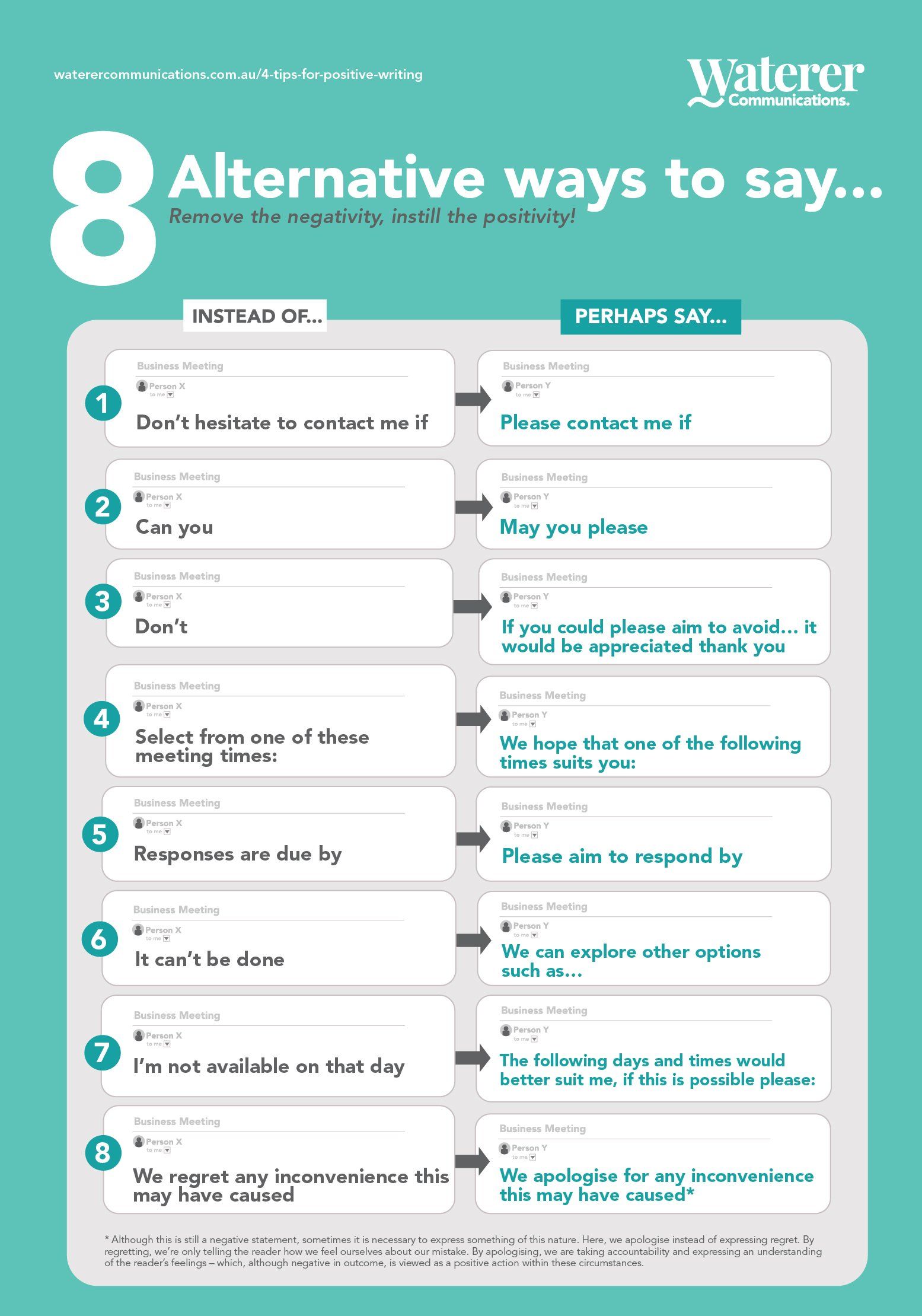Tips for Positive Writing
Have you ever mis-read a text, or had someone wrongly interpret what you’re trying to say?
It can be annoying, upsetting, even embarrassing, and can lead to feelings of being judged.
Written communication is a magnet for misinterpretation. Whether that be texts, emails, letters, or socials – one small error can result in a large amount of grief.
Yet, in the same way that written communication can have a negative impact, carefully written communication can help build trust and relationships, simply through choosing your words wisely.
Here, I provide some tips for
writing positive emails, many of which can be applied to other forms of communication. Peruse the obvious, and not so obvious, ways by which you can help dodge disasters and remain aware of your approach. You’ll also find a link to a useful resource at the end, which can act as a valuable checklist when constructing your future comms.
1. Tone
A new manager emails her employee with a task, saying, “You are required to…”, and following up with, “Your response is due by…”.
The manager believes she is simply outlining the task and setting a deadline. But the employee regards the tone as inappropriate, perhaps even a tad rude.
Will the employee now judge their manager’s character based on the one email? The likelihood is yes.
In the 1950s, Albert Mehrabian, a pioneer researcher of body language, formulated the 7-38-55% rule, whereby 7% of meaning is communicated through spoken word, 38% through tone of voice, and 55% through body language.
So, when all you have is written words, it is critical to get the tone of them right.
Tip: Before you send anything, stop for a second, and remember that the recipient of your email can’t see or hear you; they can’t read facial expressions or body language, or hear your tone. Write your email as if you are the recipient, to help ensure it’ll be received favourably. If you exude respect through choosing your words wisely, then your email is much more likely to be received and actioned with reciprocated respect.
2. Emotion
Emotions can affect the way we write. Feelings of happiness may result in friendlier emails –starting off with some positive news, perhaps, or a funny story.
But, on the contrary, feelings of negativity may influence our writing style and lead to misconstrued or even damaging messages and cracks in relationships.
Emotions are driven by both internal and external forces.
Struggles such as the Covid-19 pandemic, for example, have impacted us in so many ways.
Now more than ever we need to be extra mindful of how we write, and fully aware of our mood, before we press send.
Tip:
If your emotions are running high, and your email isn’t urgent, save the draft and return to it when you feel more optimistic. Better still, don’t start writing it until you feel a bit more level-headed. For urgent emails, it may be wise to ask a friend or close colleague to review it before sending! Likewise, it is wise to put off reading
emails until you’re in a good head space, to avoid potential misconception.
3. Subconscious negativity
The subconscious projection and perception of negativity is a tricky one, given you may not even realise it’s happening.
Just one or two words can unintentionally change a person’s interpretation.
For example, take the common phrase at the end of emails, “Do not hesitate to contact me”.
The words ‘do not’, especially when combined with ‘hesitate’, could be subconsciously perceived as negative, and perhaps even as an order, thus such a phrase could have an adverse effect.
If skim reading, the recipient may even see it as “Please do not contact me”.
It’s much ‘safer’ to say something like, “Please reach out if…” and keep the tone light and upbeat.
Tip: Before hitting send, check your emails thoroughly for any words or phrases that could be portrayed as negative. If you find any, try to turn these words and phrases around so they sound more positive. You could also ask a friend or close colleague to assist – two pairs of eyes are often better than one!
4. Questioning
Questioning is another way by which we can subconsciously project negativity and miscommunicate with colleagues or peers.
For example, ‘the boss’ wants an employee to undertake a task.
He says to his employee, “Can you do this?”.
This simple question could be interpreted as an ‘are you able to do it’ question – a question of abilities, as opposed to just allocating the task.
What the boss should ask is something like, “May you please action this?”.
It’s polite, it’s respectful, and it conveys belief in his employee to get the task done.
Tip: Check that what you’ve written is polite, and that you are indisputably asking the right question. Then, before sending to your recipient, send the email to yourself, take a break, and then read it again as the recipient. Do you like the way the email is asking you to do something? If not, what would you change to make it more appropriate? Make these changes, double-check, and if all good, you’re ready to hit send! Writing more positively will soon come naturally to you, at which time, you’ll be able to drop the checks!
A few minutes to check can save a time of regret!

Useful resource
Remove the negativity, instil the positivity!
Download the following checklist for some suggested alternative phrases.
Need more help?
If you require any copywriting assistance (websites, socials, emails, letters, articles, eulogies, speeches, award applications and more), please contact me at susan@waterercommunications.com.au.
View all services at: https://www.waterercommunications.com.au/services.
Please note that this article, and all information contained within, is based on Susan Waterer’s own opinion only, unless otherwise noted.
* Source: ‘The Definitive Book of Body Language’, first chapter, by Allan and Barbara Pease, 24 Sept 2006,
https://www.nytimes.com/2006/09/24/books/chapters/0924-1st-peas.html



